User:Trapicki/Proposal Snow Chains
Draft of Proposal for traffic limitation "snow_chains"
Rationale
This proposal defines keys and values for snow chains (a.k.a tire chains) related restrictions, traffic signs and amenities.
Routing
For routing, it is important to know about existing or possible limitations or equipment that may be necessary, which is especially true for snow chains. As snow chains are only necessary and/or required under certain conditions this may change depening on the time one travels the route, it may even change on short notice during the journey. Knowing the possible limitations beforehand allows to adjust the route or equipment accordingly and consider the implications accordingly.
In case snow chains are compulsory, places to put on snow chains (chain-up area, chain bay) may be shown to help travelers.
General rules for areas/countries, like compulsory winter tires, or requirement to have winter equipment like snow chains availble, or prohibition of use of snow chains, should not be tagged and are not part of this proposal.
Road sign
In Austria[1], Germany, Italy, Switzerland, Czeck Republic and other countries a traffic sign for "snow chains required" exists and is in common use. The UN Vienna Convention on Road Signs and Signals[2] defines a snow chain sign as D, 9 "SNOW CHAINS COMPULSORY" and E, 21 / E, 22 "CHAINS OR SNOW TYRES RECOMMENDED".
Mapping existing things means this has to be mappable, not only the sign but also the restriction on the route.
Current usage
Overpass-turbo: show_chains, snow_chains:conditional, snow_chains:variable, snow_chains:on_demand in overapss-turbo
taginfo:
- https://taginfo.openstreetmap.org/keys/snow_chains
- https://taginfo.openstreetmap.org/keys/snow_chains:conditional
- https://taginfo.openstreetmap.org/keys/snow_chains:variable
- https://taginfo.openstreetmap.org/keys/snow_chains:on_demand
Proposal
Properties of highway=*
Key snow_chains=*
Values:
snow_chains=yes: Snow chains always requiredsnow_chains=no: Snow chains never allowed
In most cases (at least in Central Europe), snow chains will be required conditionally (fixed rule, additional traffic signs) and/or on demand(issued by local authorities depending on actual situation).
Key snow_chains:conditional=*
Standard Conditional restrictions.
Like maxspeed=* usuallly with sign "snowflake", that is, when road is covered in snow or ice, or during a certain time of year.
Examples:
| Tagging | Explanation | Note | Image |
|---|---|---|---|
snow_chains:conditional=yes @ snow; yes @ ice
|
Snow chains required when road is covered in snow or ice. |
|
 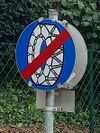 |
snow_chains:conditional=yes @ snow; yes @ ice; no @ motor_vehicle AND awd AND "driving uphill"
|
Snow chains required when road is covered in snow or ice, but not for uphill driving AWD motor vehicles. |
|
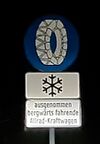 |
snow_chains:conditional=no @ motorcar AND winter_tires
|
Snow chains required, expect for motorcars (Class N) with winter tires. | 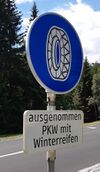 | |
snow_chains:conditional=required @ (ice AND weight>3.5t); required @ (snow AND weight>3.5t);
|
Snow chains required for vehicles with weight > 3.5 t when ice or snow on road surface. | 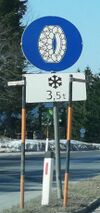 |
Key snow_chains:on_demand=*
Deduced from crossing:on_demand=*
Note in progress: maxspeed:variable=* was my first though, but "on demand" is more self-explaining, easier to understand and remember.
snow_chains:on_demand=yes- Snow chains required as announced on site. Sign may be flippable, foldable, turnable, covered, removable.- Can be combined with
snow_chains:conditional=*. - If the restriction is permanent, this tag should not be set.
Example:
| Tagging | Explanation | Note | Image |
|---|---|---|---|
snow_chains:on_demand=yes
|
Sign can be rotated. |  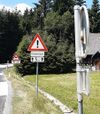 |
Place to put on snow chains
This is probably some easy accessible place beside the road, with virtually no inclination to allow rolling on the car while laying snow chains even in fresh snow. Parking restriction may apply to prevent usage as parking area and thus make putting on snow chains impossible. Known as "chain-up areas", "chain bay"
Examples:
- Austria
- B179 Fernpassstraße near Biberwier https://www.openstreetmap.org/node/3247772931
- B99 Katschbergstraße near Niedertauern Anlegeplatz (chain-up) https://www.openstreetmap.org/node/3247772931 Ablegeplatz (chain-down) https://www.openstreetmap.org/way/543640239
- B173 Eibergbundesstraße near Eiberg Articles: https://www.tt.com/artikel/12387597/kettenanlegeplatz-soll-winterchaos-verhindern https://www.tirol.gv.at/verkehr/baubezirksaemter/bba-kufstein/strassenbau/bau-strasse/archiv/kettenanlegeplatz-eiberg/ maybe https://www.openstreetmap.org/way/365879239 https://www.mapillary.com/app/?pKey=498512804607926
- S16 Arlberg Schnellestraße: Kettenanlegeplatz Bings https://www.openstreetmap.org/way/507523309 Snow chains compulsory in Austria for vehicles > 3.5 t always at ice or snow. All primary roads (Autobahn, Schnellstraße) have chain up areas where there is usually need in case of snow fall. TODO: get list/locations from ASFINAG.
- Germany
- OA9 Riedbergstraße near Obermaiselstein https://www.openstreetmap.org/way/305030048
- US
- Wikipedia Commons: https://commons.wikimedia.org/wiki/Category:Snow_chains-related_road_signs?uselang=de
Key/tags tbd. Think about parking restrictions (no parking, no parking when snow chains compulsory...)
Connection to road section tbd.
Road sign
tbd.
See Proposed features/Extended traffic signs tagging
Rendering
Road: For winter theme, add some bold/red/dashed(for "on_demand") highlighting.
Chain-up area: Like parking space, but with snow chain as symbol. Can occur alongside parking sign, if parking is allowed.
Related topics
- MUTCD/California/R
- German Forum discussion https://forum.openstreetmap.org/viewtopic.php?id=61571
- Proposed features/Snow removal station
Open Questions
- Which countries have decent usage of snow chain sign?
- How are snow chain signs properly mapped?
- There are designated places to put on snow chaines, much like
highway=rest_area. How to tag them?- How to link a snow chains road section to the appropriate "snow chain place"?
- Should "Road opened or closed" from the Vienna Convention be included?
- What about "Czech road sign Winter equipment", https://en.wikipedia.org/wiki/Snow_tire#Europe
- Should the proposal also consider "Winter Equipment", like "Winter tires", or "Snow Studs" (Austria: "Spikes")?
TODO
Before proposing
- Create proposal in private sub-page (too late...)
- Ask friendly person for comments
After proposing
- Contact renderer
- OSM Carto
- Contact Router
After acceptance
- Create wiki page
- add to "How to map..." page
- Create Feature Request in
- Editors
- JOSM
- ID
- Mercaator
- OpenStreetBrowser
References
- ↑
| StVO §51 lit. b Nr. 22 Gebotszeichen "SCHNEEKETTEN VORGESCHRIEBEN" in RIS

- ↑ https://treaties.un.org/Pages/ViewDetailsIII.aspx?src=TREATY&mtdsg_no=XI-B-20&chapter=11&Temp=mtdsg3&clang=_en%7CUN
- ↑ | StVO §54 Z. 5 lit. f "Diese Zusatztafel weist darauf hin, dass das Straßenverkehrszeichen bei Schneelage oder Eisbildung auf der Fahrbahn zu beachten ist." in RIS

Vienna Convention on Road Signs and Signals Anex 3 B.2.(i)
Snow chains compulsory Sign D, 9 "SNOW CHAINS COMPULSORY", shall mean that vehicles travelling on the road at the entrance to which it is placed shall have snow chains fitted to not less than two of their driving wheels.
Annex 5 F.7. "ROAD OPEN OR CLOSED" sign
Sign E, 21, "ROAD OPEN OR CLOSED", shall be used to show whether a mountain road, particularly a section leading over a pass, is open or closed; the sign shall be placed at the entry to the road or roads leading to the section in question. The name of the section of road (or pass) shall be inscribed in white. On the sign shown, the name "Furka" is given as an example. _ 66 _ Panels 1, 2 and 3 shall be removable. If the section of road is closed, panel 1 shall be red and shall bear the inscription "CLOSED1
- if the section is open, panel 1 shall be green and
shall bear the inscription "OPEN", The inscriptions shall be in white and preferably in several languages. Panels 2 and 3 shall have a white ground with inscriptions and symbols in black. If the section of road is open, panel 3 shall remain blank and panel 2, according to the state of the road, shall either be blank, or display sign D, 9, "SNOW CHAINS COMPULSORY", or display symbol E, 22, "CHAINS OR SNOW TYRES RECOMMENDED". This symbol shall be black. If the section of road is closed, panel 3 shall show the name of the place up to which the road is open and panel 2 shall display, according to the state of the road, either the inscription "OPEN AS FAR AS", or
symbol E, 22, or sign D, 9 .